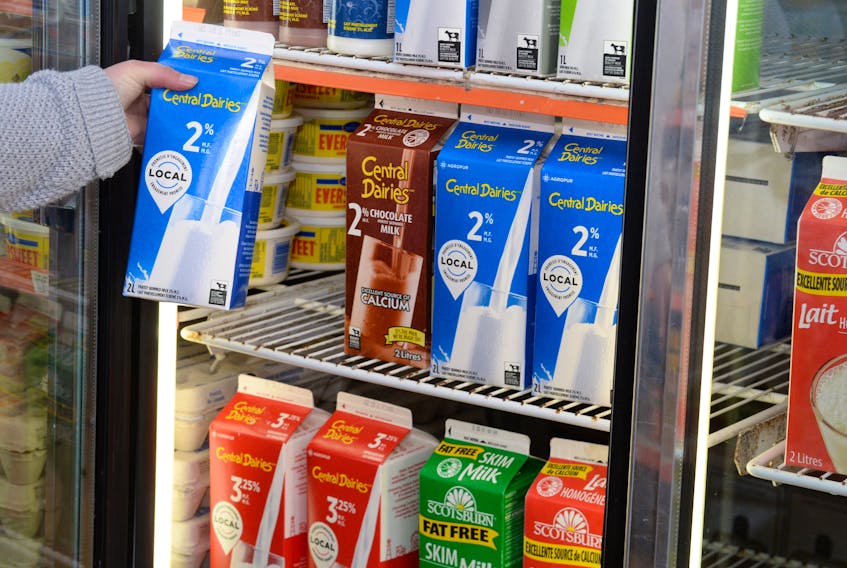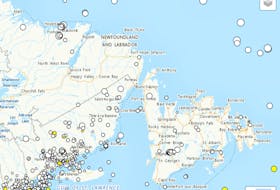ST. JOHN'S, N.L. — There will be no more crying over spilled milk at Bishops Feild Elementary come the new year.
The administration of the downtown St. John’s elementary school — currently using the former school for the deaf on Topsail Road as its temporary home — decided that as of January, it will no longer purchase milk.
According to the Newfoundland and Labrador English School District, the Bishop Feild administration found there was significant wastage of white milk purchased.
With access to white milk already offered through the School Lunch Program, Bishop Feild decided to discontinue purchasing additional milk, according to a district spokeswoman.
Rather than milk, the school is instead recommending that students bring water bottles, as it will purchase a water filling station for student and staff use.
Water was given a more prominent role in the most recent edition of Canada’s Food Guide as the recommended drink of choice, and dairy has been included with protein foods.
The district said Bishop Feild school will revisit the white milk option in the future if there is a significant demand from parents.
It’s not that white milk won’t be available at the school anymore — it will continue to be provided through the School Lunch Program and for cereal as part of its breakfast program.

It was also determined that, given the school’s breakfast program includes yogurt, cheese and fresh fruit, students have access to other sources of protein and dairy products.
As well, in the past, schools have purchased both white and chocolate milk, but the draft new School Food Guidelines, developed by the provincial government and based on the new Canada Food Guidelines, does not include chocolate milk as a recommended beverage, the district noted.
Those draft School Food Guidelines are being piloted in select district schools throughout the province, with full implementation expected in September 2020, the district said.
DIETICIANS RECOMMEND MILK
Adrianna Smallwood, a dietician and regional spokeswoman for the Dieticians of Canada, noted the misconception surrounding the revised Canada’s Food Guide, and said schools have to be careful about what message they send.
“(Dairy) is still a huge, important part of the diet. …. People look to schools to be the ones who are the most educated and they are providing the nutrition for the brain and the body, so if they are going to cut milk out of the program that’s going to make it look even worse, like it’s not important … but it really is,” Smallwood said.
She said dairy, which is still in the Canada Food Guide, is vitally important for kids, as their bones are growing until the age of 18.
Dieticians recommend at least two cups of milk for children, as it is a source of 16 important nutrients, including Calcium and Vitamin D, protein, Vitamin B-12 and Vitamin A.
She said people are turning to plant-based milks such as almond, oat and rice milk, which is understandable if there are milk allergies and lactose intolerance. Dieticians, however, recommend soy milk in those situations because it has the same protein content as cows’ milk.
Milk is also a main source of protein for children under the age of eight, Smallwood noted, adding the revisions to the Canada Food Guide reflect the changing times and that’s why dairy was included with the proteins.
“Everyone is talking about protein now. They are not talking about meat. They are not talking about cheese and dairy. They are not talking about nuts,’ she said.
TOO MUCH MILK WASTE, SAYS PARENT
Like Smallwood, parent Michael Whittle said there should be some education to explain the decision isn’t trashing milk and its importance to children’s diets. He said he will raise that point at the school council, of which he is a new member.
All parents were notified via a school flyer, and the council didn’t have input on the decision.

Whittle’s two elementary school children don’t buy milk at school, though they take cheese and yogurt in their lunches. The family are big milk drinkers at home, but he agrees there was a lot of wastage of white milk at Bishop Feild, and the big draw was what he considers sugar-laced chocolate milk, so he says the decision was valid and despite the well intentions, school milk programs have stopped working.
“I don’t see it as a big deal,” Whittle said of the opt out.
But he is well versed in nutrition and so is informed when it comes to guiding his children, and he acknowledged that may not be the case for all parents, especially given the volume of good and bad information that’s out there.
“We lead the country in obesity and heart disease, so it’s very difficult to navigate those questions,” Whittle said.
Most milk consumption nationally has been in a steady decline, according to Statistics Canada. Skim milk sales in 2018, for example, were roughly half what they were 10 years before, while one per cent milk consumption was down 34 per cent and two per cent milk — which has the biggest chunk of the market — was down by 12 per cent.
In September, the industry regulatory body, the Dairy Farmers of Newfoundland and Labrador (DFNL), launched a campaign — “No Bull” — to revitalize the province's milk industry.
Fluid milk sales in Newfoundland and Labrador have decreased by 11 per cent over the past five years, the DFNL announced at that time.
HUGE IMPACT FOR SCHOOL MILK FOUNDATION
The DFNL shares staff with the School Milk Foundation of Newfoundland and Labrador, a non-profit organization that advocates milk consumption in schools, and is supported by the Dairy Farmers, Scotsburn Dairies Ltd., Central Dairies Ltd. and the provincial government.
Bishop Feilds’ decision to no longer purchase milk outside the School Lunch Program — in which students must be registered, as families confidentially pay what they can afford, so no one is stigmatized — is not unlike that of other schools that use the school lunch program, said John Moores, general manager of both the Dairy Farmers and the School Milk Foundation.

“The decision to remove the sale of milk is a great disappointment to me and the foundation and the industry,” Moores said.
The district said the decision to place a supplementary milk order is made at the school level, and the district does not track which schools offer a milk program.
Moores noted, however, that 241 schools in the province offer milk products, and the School Lunch Program operates in 37 of those, and as far as he’s aware the 37 have taken similar action as Bishop Feild to not offer milk outside the School Lunch Program.
It’s too early to speculate on the implications for the School Milk Foundation, but the foundation will review over the next few months what the impact will mean for its future, Moores said.
The effect of removing chocolate milk will particularly be one to watch, as chocolate milk represented 70 per cent of the one million litres of milk previously sold each year in schools.
Milk in the schools is sold at a regulated, subsidized cost — 50 cents for a 250-millilitre container that would cost more than $1 in a store.
As for milk’s role in a healthy diet, Moores also noted there’s a lot of misconception about the updated Canada’s Food Guide — people wrongly think it’s gone altogether.
The dairy industry in Newfoundland and Labrador and across Canada continues to struggle with that, he said.
The Dairy Farmers are promoting the buy-local notion of milk, as all milk sold in the province, except the organic and lactose-free products, is produced and processed in Newfoundland and Labrador and is antibiotic-free and preservative-free, with no added growth hormones and no additives other than Vitamins A and D.
The industry also contends that the sugar content that has been frowned on in chocolate milk is mostly associated with the natural process.
Twitter: @BarbSweetTweets
MORE FROM BARB SWEET









